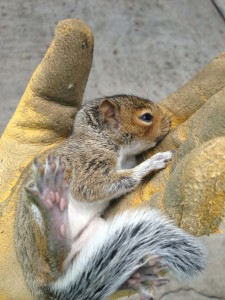Getting Squirrely in the Spring
March 25, 2016Watch for spring wildlife in your home
April 11, 2016Grey squirrel mating, gestation, growth
Whether you like feeding the squirrels at the park or spend weekends greasing your bird feeder pole to keep the little critters at bay, nobody wants to deal with the hassle of chewed electrical wires, damaged shingles or other problems caused by nesting squirrels. Understanding grey squirrel mating habits tells you when it’s time to ask a pest control expert for help finding and sealing places where squirrels may enter your home, garage or shed. If you’re already living with squirrels, an expert will know what to do and when to do it, creating the best possible outcome for both you and your squirrel guests.
Mating
Grey squirrels mate twice a year in the fall and spring, so be alert during both seasons. Females in heat will attract about 10 males from up to 500 meters away. The males will chase the female in a behavior often mistaken for play by humans. If squirrels are “playing” in your yard, mating season is likely at hand. Check your home and outbuildings for potential squirrel entry points now. It’s also wise to move your vehicles regularly for the next few week, as engines and seats have been known to harbor nesting squirrels.
Nesting
After mating, the female has about 44 days to build a nest before giving birth. Birth typically occurs February and June, so you may hear a squirrel in your home in early January or early May. If you do, don’t seal the nest opening. This traps the mother squirrel, forcing her to chew her way out. If you can’t live with the squirrel until her babies leave the nest, call a pest control service for help.
Youth
If a squirrel has gotten into your home, expect the babies to start wreaking havoc on your electrical wires, wooden framing, insulation and shingles when they are about 3 weeks old when teething (and chewing) begins. Damage may be confined at first but will likely spread to a larger area at about 8 weeks, when the babies become more mobile. A single liter may have up to 5 babies, which translates into substantial damage before they leave the nest at 70 days old. This is the most important time to trap, remove, and repair any damage and seal the entry point the mother used to gain access.
We provide damage and repair work after the removal of squirrels from your house. To learn more give us a call today.


